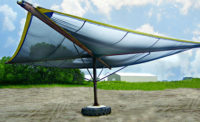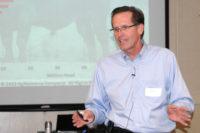The beef market tells you what it wants. You just have to pay attention.
“We know there are signals out there in the marketplace for quality. As you move further away from the end product, we know those signals are … not quite as distinct,” said Mark McCully, Certified Angus Beef LLC (CAB), at the 2016 Angus Convention in Indianapolis in November.
The brand’s vice president of supply made sense of many of those economic indicators.
“We need to make sure we’re watching the long-term trends and don’t get too carried away with some of the short-term ‘noise,’ because the decisions we’re making in our breeding programs are really about the next two, three, five years,” he said.
On a carcass-weight basis, there’s 37 percent more Prime beef today than just two years ago, compared with Select grade, which is down 21.7 percent.
“This year we actually see a higher percentage of dollar contribution is coming from branded product than Select,” McCully said, noting branded beef accounts for 16.3 percent of total industry revenue (see Figure 1).
“Not all beef is created equal and not all beef brings the same price out in the marketplace,” he said.
Through the third quarter of 2016, carcass cutout values showed a $35-per-hundredweight advantage for Prime over Select. That reward potential may help explain why 78 percent of cattle today sell on alternative marketing agreements such as value-based grids, compared with just 52 percent a decade ago.
The bar on such arrangements keeps moving higher. When 76 percent of fed cattle are grading Choice, beating plant averages is more difficult than it was in 1997 when barely more than half reached that level. Most grids only pay a Choice premium on that share of a load that exceeds the plant average.
“We get this question a lot: ‘Have we gotten them to grade high enough? We’ve selected for quality long enough — maybe we ought to go select for something else,’” McCully said. “If you want to continue to reap the premiums, or if your customers do, you’ve got to be better than the average. That’s how these systems work.”
Producers sometimes tell him they must give up pounds to get quality, but he showed that the average Certified Angus Beef® (CAB®) brand qualifying carcass is seven pounds heavier than the overall industry average.
“I dispel the myth that high-quality cattle aren’t also high-producing, high-performing, heavy cattle because, again, the data suggests you don’t give up weight for quality,” McCully said.
Showing a grid marketing example with cattle grades ranging from 0% Prime and 14% CAB for the low group to 15% Prime and 55% CAB for the high group, he figured a carcass weight 65 lb. lighter for the poor group compared to the excellent.
“I know you don’t have to do this, but how much weight could you give up and still keep your dollars the same?”
With those high-grading cattle, the quality premiums would make up for dropping 65 pounds in carcass weight.
The Choice-Select spread runs on a seasonal pattern. There are times when those “excellent” cattle would be more advantageous than others, but McCully noted the long-term signal is clear.
“We hear from time to time when the Choice-Select spread gets to zero, or goes negative. The reality is, that doesn’t happen too often,” he said. That is less than 2 percent of the time, compared with more than 35 percent of the time that spread is $10 or more (see Figure 2).
Even while producing much less Select in 2016, packers continue to pay up for Choice.
“The discounts for [yield grade 4s] and Y5s have narrowed over the last several years, which in and of itself has been a quality signal,” he said. The more cow-calf producers know and communicate about their cattle, the better position they are in to capture additional value.
“Nobody wants to pay more for cattle just because,” McCully said. “We’re starting to see more value around the data: the carcass history, the reputation, where these cattle came from, what the genetics have been, how they’ve been managed.”
He predicts that will continue to be more important with cow inventory numbers on the upswing.
“Feeder cattle supplies have been pretty tight. All of them have been worth a lot of money,” he said. “What’s going on right now? We’ve got more supplies out there; guess who gets to be a little pickier? The feeder.”
Producers who are investing in high-quality genetics need to do a better job marketing them, McCully said.
“If you’re going to take a set of premium calves and you’re going to run them down to the sale barn and not tell anybody anything about them, guess what? They’re going to probably bring the average price,” he said. “You take a premium product, market it as a commodity, you’re probably going to get a commodity price.” NP
For more information, contact Miranda Reiman, Industry Information, Certified Angus Beef LLC, at MReiman@certifiedangusbeef.com or (308) 784-2294.








